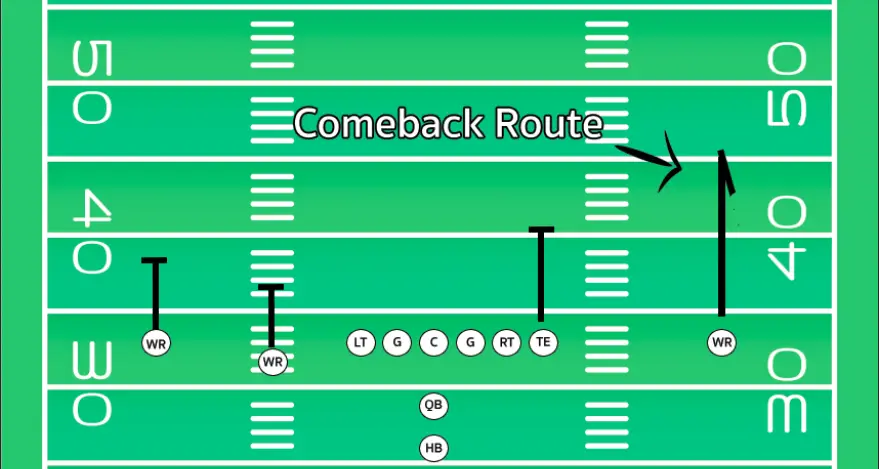A comeback route in football is a receiving pattern that features a receiver running a predetermined distance downfield only to stop suddenly and turn back towards the quarterback and the sideline.
Comeback routes are typically shorter routes with the majority of these receiving patterns being run about ten yards down the field.
When running a comeback the idea is to fool the defender into thinking you are running a go/fly route.
When running a go route you will start the route the same as a comeback route. The receiver will run full speed down the field for the first few yards.
If the defender believes the receiver is going deep he will turn his hips and start to run side by side with the receiver.
Ideally, the receiver wants to get the defender to turn his hips prior to him cutting back towards the quarterback.
This way the defender’s momentum will have him travelling deeper into the defensive backfield. This should allow the receiver a chance to achieve separation when he makes his break.
What To Know About Comeback Routes
Now that you have learned what a comeback route is in football it’s time to check out some of the key factors that make this route effective.
Below we will break down the main things you need to know about comeback routes.
Curls And Comebacks Are Different
One thing you need to know about comeback routes is that they are different from a curl route. These routes look very similar at first glance and often result in the fans and players confusing the two.
A comeback route occurs when a player turns back towards the sideline to look for the pass. While a curl route has the receiver turning back towards the middle of the field.
Essentially these routes are the same except for the direction in which the players are turning to come back to the ball.
Comeback routes are more often used in two-minute drill situations due to their close proximity to the sideline. This allows receivers to step out of bounds quickly if they want to stop the clock.
Timing Is Everything
Another factor about comeback routes that you should know is that timing is everything. After making a cut on a comeback route the receiver is going to be at a standstill. This means there is only going to be a short window in which the receiver is open.
Additionally, if a comeback route is intercepted there is a high chance of a pick-six occurring.
Since this route is near the sideline and the defender is going to have momentum towards the endzone these passes are often taken back for a touchdown if they are picked off.
This is why the receiver and the quarterback need to be on the same page when it comes to the timing of the route. The quarterback should throw this pass immediately after the receiver has started making his cut.
Route Depth Often Changes
One interesting thing about comeback routes is that the depth of these routes often changes. Comeback routes are often run in order to get a first down or touchdown.
When this is the case the receivers do not need to go any deeper down the field than the first down marker or the endzone. This means if you are close to the end zone the depth of this route is going to be shorter.
And if you are facing a third and long situation you may find the comeback route will be longer than usual in order to give the receiver a chance to get the first down.
Generally, the depth of this route is going to be quite short in order to keep a one-on-one matchup between the receiver and the defender. On a deeper route such as a skinny post, the safety will often help out.
So long as the comeback route is kept short and close the sideline the safety will not be able to help the cornerback in coverage.
The depth of this route must be clearly communicated prior to the play otherwise the players may find themselves out of sync.

